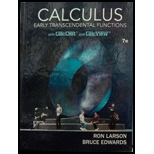
Concept explainers
Escape Velocity To escape Earth's gravitational field, a rocket must be launched with an initial velocity called the escape velocity. A rocket launched from the surface of Earth has velocity v (in miles per second) given by
where v0 is the initial velocity, r is the distance from the rocket to the center of Earth. G is the gravitational constant. M is the mass of Earth, and R is the radius of Earth (approximately 4000 miles).
(a) Find the value of v0 for which you obtain an infinite limit for r as v approaches zero. This value of v0 is the escape velocity for Earth.
(b) A rocket launched from the surface of the moon has velocity v (in miles per second) given by
Find the escape velocity for the moon.
(c) A rocket launched from the surface of a planet has velocity v (in miles per second) given by
Find the escape velocity for this planet. Is the mass of this planet larger or smaller than that of Earth? (Assume that the mean density of this planet is the same as that of Earth.)
Trending nowThis is a popular solution!

Chapter 2 Solutions
Calculus: Early Transcendental Functions
- 2. Suppose f(x) = 3x² - 5x. Show all your work for the problems below. a. Evaluate f(-3). If you have multiple steps, be sure to connect your expressions with EQUALS SIGNS. (3 points)arrow_forward4c Consider the function f(x) = 10x + 4x5 - 4x³- 1. Enter the general antiderivative of f(x)arrow_forwardA tank contains 60 kg of salt and 2000 L of water. Pure water enters a tank at the rate 8 L/min. The solution is mixed and drains from the tank at the rate 11 L/min. Let y be the number of kg of salt in the tank after t minutes. The differential equation for this situation would be: dy dt y(0) =arrow_forward
- • • Let > be a potential for the vector field F = (−2 y³, −6 xy² − 4 z³, −12 yz² + 4 2). Then the value of sin((-1.63, 2.06, 0.57) – (0,0,0)) is - 0.336 -0.931 -0.587 0.440 0.902 0.607 -0.609 0.146arrow_forwardThe value of cos(4M) where M is the magnitude of the vector field with potential ƒ = e² sin(лy) cos(π²) at x = 1, y = 1/4, z = 1/3 is 0.602 -0.323 0.712 -0.816 0.781 0.102 0.075 0.013arrow_forwardThere is exactly number a and one number b such that the vector field F = conservative. For those values of a and b, the value of cos(a) + sin(b) is (3ay + z, 3ayz + 3x, −by² + x) is -0.961 -0.772 -1.645 0.057 -0.961 1.764 -0.457 0.201arrow_forward
- A: Tan Latitude / Tan P A = Tan 04° 30'/ Tan 77° 50.3' A= 0.016960 803 S CA named opposite to latitude, except when hour angle between 090° and 270°) B: Tan Declination | Sin P B Tan 052° 42.1'/ Sin 77° 50.3' B = 1.34 2905601 SCB is alway named same as declination) C = A + B = 1.35 9866404 S CC correction, A+/- B: if A and B have same name - add, If different name- subtract) = Tan Azimuth 1/Ccx cos Latitude) Tan Azimuth = 0.737640253 Azimuth = S 36.4° E CAzimuth takes combined name of C correction and Hour Angle - If LHA is between 0° and 180°, it is named "west", if LHA is between 180° and 360° it is named "east" True Azimuth= 143.6° Compass Azimuth = 145.0° Compass Error = 1.4° West Variation 4.0 East Deviation: 5.4 Westarrow_forwardds 5. Find a solution to this initial value problem: 3t2, s(0) = 5. dt 6. Find a solution to this initial value problem: A' = 0.03A, A(0) = 100.arrow_forward2) Drive the frequency responses of the following rotor system with Non-Symmetric Stator. The system contains both external and internal damping. Show that the system loses the reciprocity property.arrow_forward
- Algebra & Trigonometry with Analytic GeometryAlgebraISBN:9781133382119Author:SwokowskiPublisher:Cengage
 Algebra: Structure And Method, Book 1AlgebraISBN:9780395977224Author:Richard G. Brown, Mary P. Dolciani, Robert H. Sorgenfrey, William L. ColePublisher:McDougal Littell
Algebra: Structure And Method, Book 1AlgebraISBN:9780395977224Author:Richard G. Brown, Mary P. Dolciani, Robert H. Sorgenfrey, William L. ColePublisher:McDougal Littell
 College AlgebraAlgebraISBN:9781305115545Author:James Stewart, Lothar Redlin, Saleem WatsonPublisher:Cengage Learning
College AlgebraAlgebraISBN:9781305115545Author:James Stewart, Lothar Redlin, Saleem WatsonPublisher:Cengage Learning Algebra and Trigonometry (MindTap Course List)AlgebraISBN:9781305071742Author:James Stewart, Lothar Redlin, Saleem WatsonPublisher:Cengage Learning
Algebra and Trigonometry (MindTap Course List)AlgebraISBN:9781305071742Author:James Stewart, Lothar Redlin, Saleem WatsonPublisher:Cengage Learning Functions and Change: A Modeling Approach to Coll...AlgebraISBN:9781337111348Author:Bruce Crauder, Benny Evans, Alan NoellPublisher:Cengage Learning
Functions and Change: A Modeling Approach to Coll...AlgebraISBN:9781337111348Author:Bruce Crauder, Benny Evans, Alan NoellPublisher:Cengage Learning





